
Chorispora tenella is a species of flowering plant in the mustard family known by several common names, including purple mustard, blue mustard, musk mustard, and crossflower. This mustard is native to parts of Eurasia but is well known in other parts of the world, particularly in temperate regions, as an introduced species and a noxious weed.

Prunus tenella, the dwarf Russian almond, is a species of deciduous shrub in the genus Prunus, native to steppes of Eastern Europe and Western Siberia, as well as dry open sites of Caucasus, Western and Central Asia.

Nebria is a genus of ground beetles native to the Palearctic, the Near East and North Africa. There are more than 500 described species in Nebria.

Nebria brevicollis, belonging to the Carabidae family, is a ground beetle. With nearly 500 species and over 100 subspecies, N. brevicollis is the most diverse genus within the Nebriini tribe of ground beetles. Members of the genus occupy a wide range of habitats. Nebria brevicollis is native to Europe and the Near East but has been introduced to the western United States and Canada. Its rapid expansion in North America is characteristic of an invasive species. Due to the variation in habitat, their diet consists of small arthropods including Collembola, Diptera, earthworms, mites, and spiders.

Nebria livida is a species of ground beetle with two subspecies:

Osmadenia is a genus of flowering plants in the family Asteraceae. It contains the single species Osmadenia tenella, which is known by the common name false rosinweed.

Nebriinae is a subfamily of ground beetles in the family Carabidae. There are about 12 genera and more than 840 described species in Nebriinae.
Nebria aetolica is a species of ground beetle in the Nebriinae subfamily that can be found in Albania, Greece, and North Macedonia.
Nebria dahlii is a species in the beetle family Carabidae, found in Europe.
Nebria germarii is a species of ground beetle in the Nebriinae subfamily that can be found in Austria, Germany, Italy, Liechtenstein, Switzerland, and in every state of former Yugoslavia, except for North Macedonia.
Nebria kratteri is a species in the beetle family Carabidae. It is found in Italy, North Macedonia, Albania, and Greece.
Nebria tatrica is a species of ground beetle in the Nebriinae subfamily that can be found in Poland Czech Republic and Slovakia.
Nebria tenella is a species of black coloured ground beetle in the Nebriinae subfamily that can be found in Georgia and Russia.
Nebria tenella megrelica is a subspecies of ground beetle in the Nebriinae subfamily that is endemic to Georgia.
Nebria tenella tenella is a subspecies of black coloured ground beetle in the Nebriinae subfamily that can be found in Georgia and Russia.
Nebria cordicollis is a species of black coloured ground beetle from Nebriinae subfamily that can be found in Switzerland, Italy, and Germany. The species is about 5 millimetres (0.20 in) long.

Physaria tenella is a species of flowering plant in the family Brassicaceae known by the common names Moapa bladderpod and slender bladderpod. It is native to western North America from Utah to Sonora, where it grows mainly in desert habitat. This is an annual herb producing several hairy multibranched erect to spreading stems sometimes exceeding half a meter long. The basal leaves are up to 6.5 centimeters long and sometimes toothed, and there are smaller leaves higher on the stem. The inflorescence is a raceme of flowers at the tip of the stem. The mustardlike flower has four orange to bright yellow petals each up to a centimeter long. The fruit is a plump, hairy, rounded capsule containing flat orange seeds.
Myrciaria tenella, commonly known as cambuí or camboim, which are also used to describe Myrciaria cuspidata and Myrciaria delicatula; or more specifically jabuticaba-macia, and cambuí-açu, is a species of plant in the family Myrtaceae.







